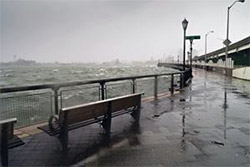The best way to ensure buildings withstand natural disasters is to protect their most vulnerable areas. Adequate waterproofing of below-grade structures—from retaining walls to tunnels to foundations—is crucial. Weather patterns are not as predictable as they once were, with more extreme weather-related damage occurring in places we would have never expected.
Take Hurricane Sandy as an example. Slamming the Eastern Seaboard on Oct. 29, 2012, it was among the worst natural disasters ever to hit the U.S., causing at least $65 billion in damages. The storm surge rose more than 13 feet above the average low tide, resulting in extensive power outages, severe flooding, and thousands of properties destroyed. New York City was the most severely impacted due to its extensive network of below-grade infrastructure: subways, tunnels, and coastal structures. During the height of the storm, the Hudson River breached the esplanade, quickly spreading through the adjoining streets and flooding nearby buildings.
 Manhattan is the epicenter for many industries, especially the financial markets. One company in particular, Bloomberg LP, has become the backbone for financial transactions and, as such, houses a computer server farm in its Manhattan office for critical systems that support worldwide financial transactions. Few could have foreseen the seemingly well-constructed building’s vulnerability to flood waters, but it is located one block from the Hudson River. The power plant that runs the infrastructure is at street level and the mechanical room received 2.5 feet of water during the storm.
Manhattan is the epicenter for many industries, especially the financial markets. One company in particular, Bloomberg LP, has become the backbone for financial transactions and, as such, houses a computer server farm in its Manhattan office for critical systems that support worldwide financial transactions. Few could have foreseen the seemingly well-constructed building’s vulnerability to flood waters, but it is located one block from the Hudson River. The power plant that runs the infrastructure is at street level and the mechanical room received 2.5 feet of water during the storm.
Bloomberg wanted to make sure this never happens again. To mitigate concerns of similar flooding in the future, the building owners contacted structural engineering firm Weidlinger Associates and WSP Flack + Kurtz to create a solution that would protect the highly important machinery in the pump room. The designers worked with New England Dry Concrete, a waterproofing consultant and distribution partner of Kryton International. They decided on the following three steps:
Fortify the mix. The owners did not want to move any existing structures, so the solution was to pour new, 15-foot concrete walls within the building that would wall off and surround the ground-level mechanical room. To waterproof the walls, they added Kryton’s Krystol Internal Membrane (KIM) to the concrete mix. This chemical admixture is added to fresh concrete to reduce the permeability of concrete and provide permanent waterproof protection. When added to the concrete mix, KIM’s chemicals grow millions of needle-like crystals throughout the concrete matrix, blocking the movement of water in all directions. These crystals remain dormant throughout the life of the structure until they have contact with incoming water, which causes the crystals to reactivate and block the water from penetrating.
The newly created room is accessible via submarine doors.
Pack the joints. For added protection, the crew applied Krystol Waterstop System to the concrete-to-concrete joints of the walls. The system incorporates two cementitious products that react with water the same way as the KIM admixture, giving the structure extra waterproofing protection along the joints. Because the system uses a proprietary integral crystalline waterproofing formula, it also has the ability to self-seal small cracks that may develop over time.
Coat the walls and floor. Pouring a new slab fortified with the waterproofing admixture would have been the best course of action for the floor, but the designers did not want to move any of the machinery in the room. Instead, they chose to apply Kryton’s T1 & T2 Surface-Applied Waterproofing System as a slurry to the topside of the slab and to exterior walls to provide as much protection as possible. The system delivers the crystalline product into the pores and capillaries of the concrete in the same manner as a hardener or densifier. The waterproofing product reacts with unhydrated cement and water to create crystals in the concrete matrix. The wetter the concrete gets, the more the crystals grow, making the concrete even more waterproof than before.
Now the only way floodwater could impact the mechanical room is if the water rose high enough to breach the 15-foot walls, says Greg Maugeri, CEO of New England Dry Concrete. “That’s an unthinkable scenario, as I am sure much of New York City would have to be underwater.”
Contributed by New England Dry Concrete. Visit www.kryton.com for more information about the products mentioned in this article.
Source: The Concrete Producer